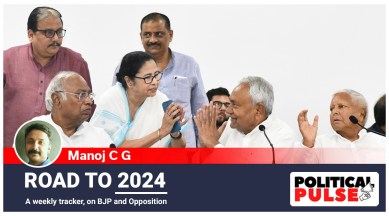Road to 2024: Between Bengaluru and Mumbai, INDIA alliance hits familiar poll bumps
The Kerala, Bengal bypolls, the AAP pitch in MP, Chhattisgarh indicate just the kind of knotty problems that stitching together the loose ends will pose

ON September 1, top leaders of the 26-party INDIA alliance will be in a huddle in Mumbai – their third meeting after Patna and Bengaluru – to crystallize their electoral plan to take on the BJP in the Lok Sabha elections. On the same day, Kerala Chief Minister Pinarayi Vijayan would be campaigning in Puthuppally, where his party the CPI(M) and the Congress are pitted against each other in a high-stake by-election duel.
The seat fell vacant after the demise of Congress heavyweight and Vijayan’s predecessor Oommen Chandy.
monthly limit of free stories.
with an Express account.
In defence of the INDIA alliance, it can be argued that its main rival – the BJP – is not a party of note in Kerala, posing any immediate danger to either the Congress or the CPI(M). And that, given that the two of them are the main rivals in Kerala, the CPI(M) could not have given the Congress a walkover in Puthuppally, while the Congress has prestige attached to the seat the late Chandy had held since 1970.
But then, cut to West Bengal. The Congress and the CPI(M) are together here in the race for the Dhupguri by-election in North Bengal.
However, their presence in the race for the seat that was won by the BJP in the 2021 Assembly elections is queering the pitch for their INDIA alliance partner Trinamool Congress. The TMC has a point to prove in the high-stake battle, ahead of the Lok Sabha elections, given that it lost the last Assembly bypoll, held in January this year, and given that in 2021, the BJP had bagged 30 of 54 seats in north Bengal.
The TMC has left no stone unturned to win Dhupguri, with both Chief Minister Mamata Banerjee and her influential nephew Abhishek Banerjee set to campaign, along with some 37 leaders, including MPs.
For the BJP, the above two are more examples of the hollowness of the stated raison d’être of the alliance – to “save India” from the BJP.
And, there are more contradictions.
Aam Aadmi Party (AAP) supremo Arvind Kejriwal was in Chhattisgarh and Madhya Pradesh over the weekend pushing his party’s “guarantees”. This was after making the point at the first meeting of the INDIA alliance parties in Patna that they should all put on hold plans for expansion in newer territories till the Lok Sabha elections.
In Chhattisgarh, Kejriwal announced nine poll “guarantees”, the term itself reminiscent of the Congress winning formula in recent Himachal Pradesh and Karnataka Assembly elections, riding on the back of welfare/populist promises called “guarantees”.
In Madhya Pradesh’s Satna, Kejriwal pitched himself as the “chacha” who could counter BJP Chief Minister Shivraj Singh Chouhan, affectionately called “mama” by his supporters.
In Rajasthan, the AAP has announced plans to field candidates in 26 seats, spread across Ajmer, Ganganagar, Kota, Dausa, Banswara, Sikar, Hanumangarh, Jaipur and Alwar districts.
The Congress is the dominant opposition force in all the three states, facing a tough competition from the BJP.
Kejriwal’s visit to Chhattisgarh and Madhya Pradesh came soon after fresh tension erupted between the Congress and AAP in Delhi, over the hard talk emerging from the Congress side. At a meeting held recently, the Congress high command told its Delhi leaders to strengthen the party organisation in all the seven seats in the state, in view of the forthcoming Lok Sabha elections – setting off alarm bells in the AAP regarding the plans of its INDIA alliance partner.
The AAP reaction, questioning the Congress’s claim to all the seven seats, revealed in a way that it was eager for a tie-up with the Congress in Delhi. It also reinforced the Congress central leadership’s tactical silence on whether it would enter into an alliance with the AAP in Delhi, or for that matter in Punjab. The state units of the Congress in both the states are strongly opposed to any association with the AAP.
As the leaders head to Mumbai to brainstorm on the way ahead – with the larger idea being to field one common candidate against the BJP in as many Lok Sabha seats as possible – these pinpricks are a pointer to the irritants ahead for the alliance, which the BJP rubbishes as a friendship of convenience.
Another sign of the stormy patch ahead is the fact that the parties are yet to announce the composition of the promised 11-member coordination committee. All the major parties were to suggest one name each for the proposed body. Sources said there is lobbying within the Congress by a couple of leaders to be on the committee.
With less than 10 days left for the Mumbai meeting, where talks on the tricky issue of seat-sharing are apparently to be tackled, the challenge before the parties now seems to be to reinforce and internalise their common minimum purpose rather than drafting a common minimum programme.